Ask Ethan: Is It Really Impossible For A Jupiter-Like Planet To Orbit A White Dwarf?

We just found a system that we can’t explain. Here’s what’s going on.
One of the most fascinating facts about the Universe is that there’s so much of it out there. There are some 2 trillion galaxies strewn about across the observable Universe, with our own home galaxy containing somewhere around 400 billion stars all by itself. That’s 400 billion planetary systems, 400 billion opportunities for biochemical reactions, and 400 billion unique configurations just waiting for us to identify and observe them. Recently, we’ve discovered a new system — of a Jupiter-sized planet orbiting very close to a white dwarf — that challenges our notions of what ought to exist. What does this novel system mean, and why is it so puzzling? That’s what Patreon supporter Dominic Turpin wants to know, asking:
“I just read we found a Jupiter sized planet orbiting a white dwarf star. [The article] said the planet found a way to survive the supernova explosion. Is it possible the white dwarf simply captured a rogue planet after the supernova?”
There’s a lot that’s being misinterpreted here, but there is a fascinating truth: for the first time, we’ve found a giant planet orbiting a white dwarf star, and it’s extremely close to the white dwarf, completing an orbital revolution in just 34 hours. Here’s why it’s a puzzle, and what the resolution could possibly be.

In general, there are three completely independent possible fates for stars, and they’re overwhelmingly determined by one factor: how much mass was the star born with? The most massive stars, born with eight or more times the mass of our Sun, will burn through the hydrogen in its core, swell into a red giant and burn helium in its core, and then proceed to burning carbon, neon, oxygen, and silicon before dying in a catastrophic supernova explosion. Typically, this leaves only the collapsed core behind: either a neutron star or a black hole.
Sun-like stars, with masses between ~40% and ~800% the Sun’s mass, will live a like much like our own Sun: they’ll burn through the hydrogen in their core, expand into a helium-burning red giant, and then gently blow off their outer layers while the core contracts down to form a white dwarf, primarily composed of carbon and oxygen.
On the extreme low-mass end, stars between just ~8% and ~40% of the Sun’s mass will burn hydrogen only, contracting down to form a helium-only white dwarf at the end of their lives.
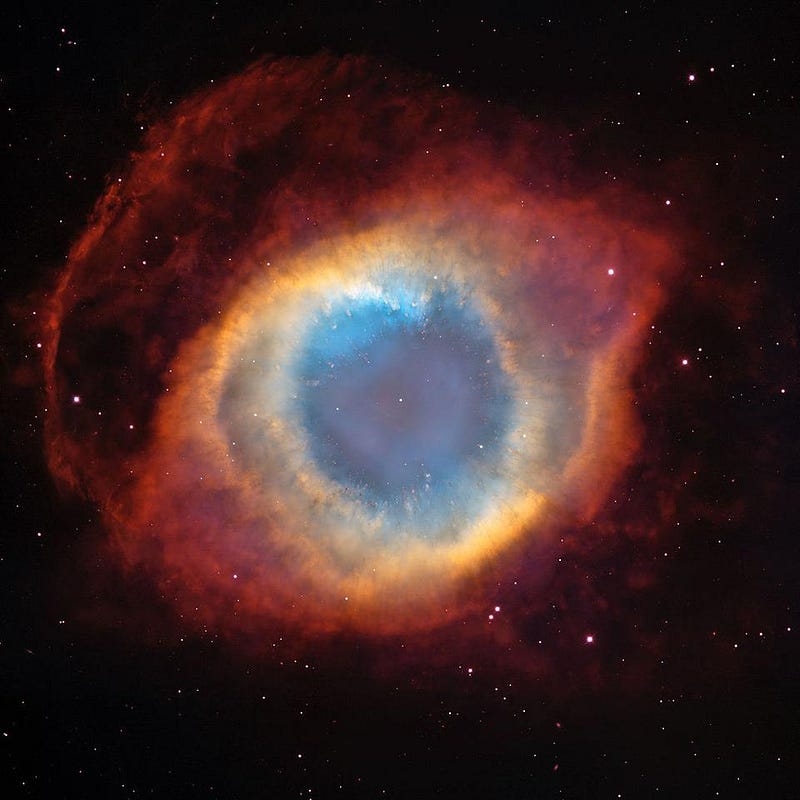
When we see a white dwarf star, we can be confident that this is a stellar remnant whose core didn’t collapse and implode, and whose progenitor star didn’t die in a supernova explosion. There may be other ways to make a white dwarf — a very massive red giant could have its outer layers stripped away, for instance, “aborting” a potential supernova — but the stellar deaths that create them are always gentle, not cataclysmic.
The puzzle is this: when a Sun-like star goes down the path towards becoming a white dwarf, it’s expected to destroy much of the solar system that has historically orbited it.
First, the star swells into a red giant, with its core contracting and heating up, hydrogen fusion occurring in a shell surrounding the core, and eventually fusing helium in the central core. During this stage, the star swells to more than a million times its initial volume and more than 100 times its initial radius, while its energy output skyrockets: red giant stars can be over a thousand times as luminous as the star was previously.
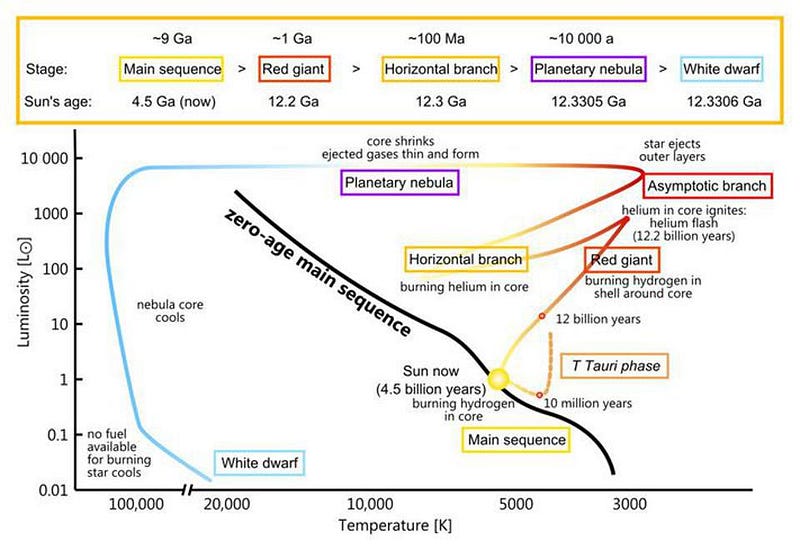
For hundreds of millions of years, the red giant star will fuse helium into carbon in its core, gradually shedding mass as its outer layers periodically eject matter into a halo surrounding the solar system. Finally, as the end of the star’s life approaches, the outer layers — composed primarily of lighter elements like hydrogen and helium — are blown off into a planetary nebula, while the core contracts down to form a white dwarf. That’s the expected life cycle for the star itself.
But what happens to the planets orbiting that star, or to the remainder of that solar system?
When the star first becomes a red giant, the innermost planets get engulfed and swallowed: Mercury and Venus will definitely go this route when the Sun becomes a red giant, and Earth likely will as well. The radiation is so intense that the icy bodies of the solar system, like Kuiper belt objects, will largely sublimate away, leaving only their rocky cores behind. And any gas giants that are too close to a giant star like this may even have their atmospheres evaporated away, leaving only their exposed planetary cores.
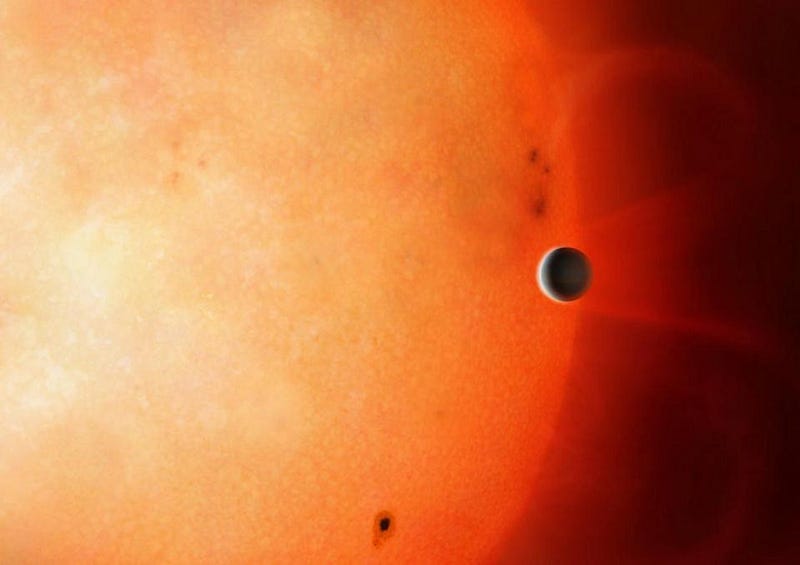
Additionally, gravitational instabilities can be induced in the orbits of the remaining planets. Many models that seek to simulate the far future of our Solar System show at least one of our inner planets getting ejected, while the mass loss that occurs towards the end of the star’s life can cause the outer planets to spiral away from the star and potentially even become gravitationally unbound. The final stages of a solar system, just like the early stages, can result in the creation of many rogue planets.
But this doesn’t necessarily mean that no planets can ever orbit close in to a white dwarf. One of the other things that happens is that the material that was once part of the central star, as it gets ejected, can collide with the orbiting planets, acting like a source of friction. Just as an orbital satellite coasting through the tenuous upper atmosphere will slowly lose momentum (both linear and angular momentum) and fall back to Earth, the planets orbiting a dying Sun-like star will experience a similar effect, spiraling in towards the central star over time, so long as the matter blown off around the dying star intersects the planet-in-question’s orbit.
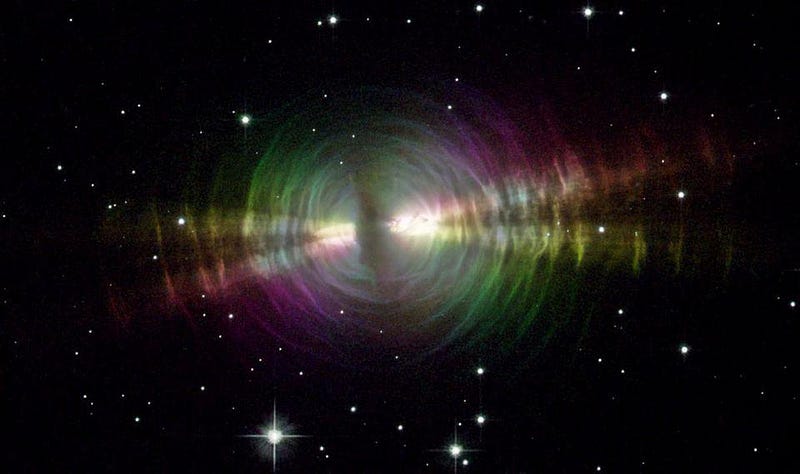
All of that is just theory, of course. But in astrophysics, as in all physical sciences, the theoretical predictions we make are only useful when they’re confronted with observations and measurements about the actual Universe itself. Although we’ve managed to detect thousands of exoplanets around stars, we know of very few around stellar corpses like white dwarfs. We’ve detected a few planets orbiting pulsing neutron stars from the time-delay of the arriving pulses, but the evidence of planets around white dwarfs has largely been indirect:
- from rocky material in a white dwarf’s atmosphere,
- via warm debris disks around the stellar remnant,
- or from rocky (or icy) debris that’s likely from a tidally destroyed former planet that hasn’t quite been swallowed.
But one of the big questions that this has led to is whether a planet can survive, intact, to orbit close in to a white dwarf. White dwarfs are as massive as entire stars, but only about the physical size of a rocky planet like Earth. Each time you halve your orbital distance around a white dwarf, the tidal forces on you increase by a factor of 8; could a planet survive orbiting so close to such a massive object?
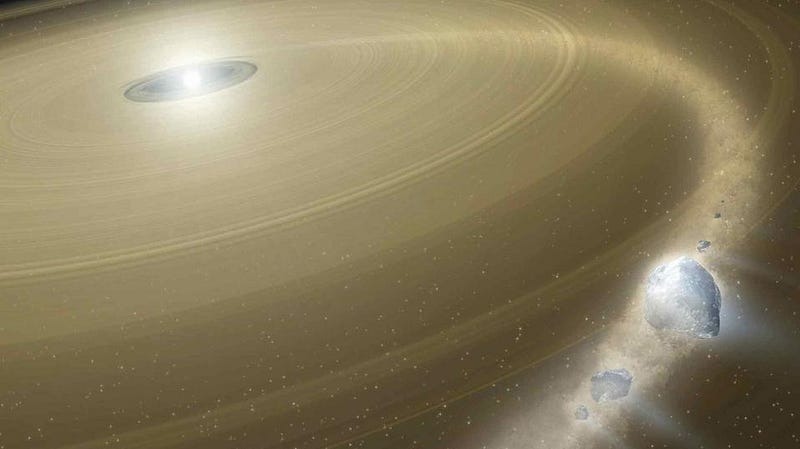
That’s where the newest study (free version available here) comes in: for the first time, a candidate (i.e., not independently confirmed) planet has been found orbiting a white dwarf. The star system itself is known as WD 1856+534, and is located only 80 light-years away. Based on its temperature, it became a white dwarf approximately 6 billion years ago, back before our Solar System even formed. And, after being targeted by NASA’s Transiting Exoplanet Survey Satellite (TESS), a characteristic and periodic dimming was found, signaling the presence of a transiting exoplanet.
Transits are expected to be rare around white dwarfs, as the odds of getting a serendipitous alignment — where the planet actually passes in front of a small-sized stellar remnant — are very low. Over 1,000 white dwarfs were surveyed by TESS, and WD 1856+534 was the first one to show evidence of this periodic dimming. Based on the data obtained, the planet is very close to the white dwarf, completing an orbit every 1.4 days (34 hours), but being quite large: approximately the size of Jupiter, taking 6-to-8 minutes to complete a full transit.
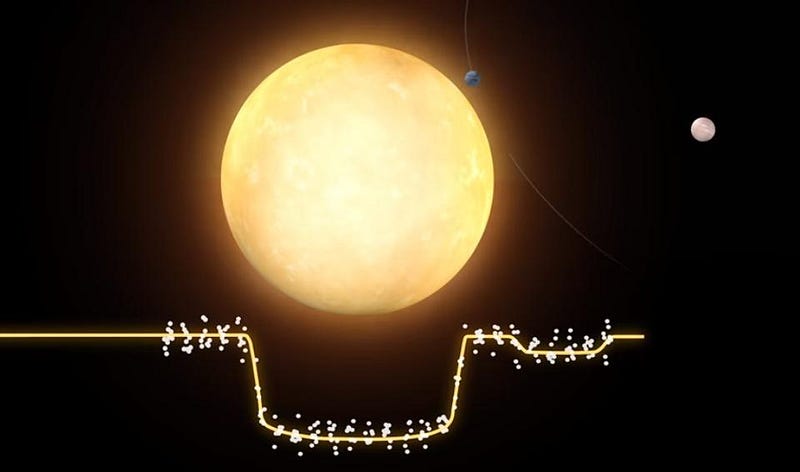
The dimming of the white dwarf is enormous, as two sets of 2019 observations showed that the light output was reduced by 56% during transits, as opposed to typically less than 1% for most transits around normal stars. Normally, we’d be able to follow-up and confirm the existence of the planet and measure its mass by observing the spectral lines of the star and how those lines redshift and blueshift over time, but this particular white dwarf is unusually featureless. As the authors write:
“the spectrum of WD 1856 is classified as type DC, a featureless continuum with no strong optical absorption or emission features. Optical and near-infrared spectra from the MMT Telescope, Lick Shane Telescope, Gemini-North telescope, and Hobby Eberly Telescope confirmed this classification. The lack of strong spectroscopic absorption features precludes precise Doppler observations.”
There’s no excess long-wavelength radiation, telling us that this isn’t an ultra-cool star or brown dwarf on its own; it’s almost certainly a giant planet, but one that’s survived intact, devoid of any detectable debris, orbiting extraordinarily close to a compact stellar remnant.
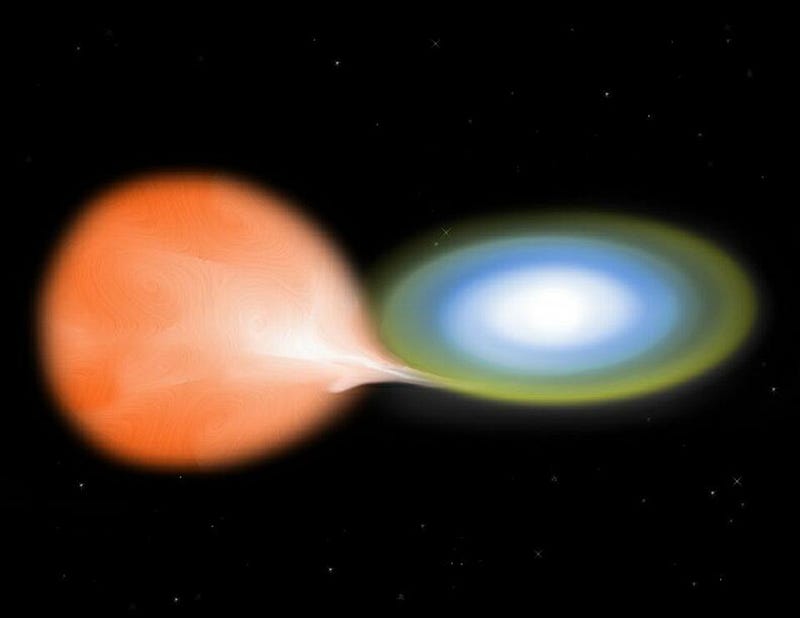
Current theoretical ideas that are used to explain other known systems all run into problems when applied to this white dwarf-giant exoplanet system. The common envelope theory — where a giant star engulfs a lower-mass companion, ejecting the envelope while the companion spirals in — this white dwarf-giant planet system has by far the lowest mass/longest orbital period combination of any sych system. Put simply, the mass of the exoplanet is too small to eject the envelope of the giant star that gave rise to the white dwarf.
The “captured rogue planet” scenario fares no better, as a system of pre-existing masses would need to be ejected (similar to how Triton ejected Neptune’s pre-existing moons) to bring the planet into a circular orbit, and the same “common envelope” problems still arise.
Instead, the most viable known scenario is through dynamic instabilities that arise over long cosmic times. Simulations indicate that a planet like this observed exoplanet could be thrown into highly eccentric orbits which come very close to the parent star, and then circularize over billions of years. Given the white dwarf’s advanced age, this is a plausible pathway towards forming this system.
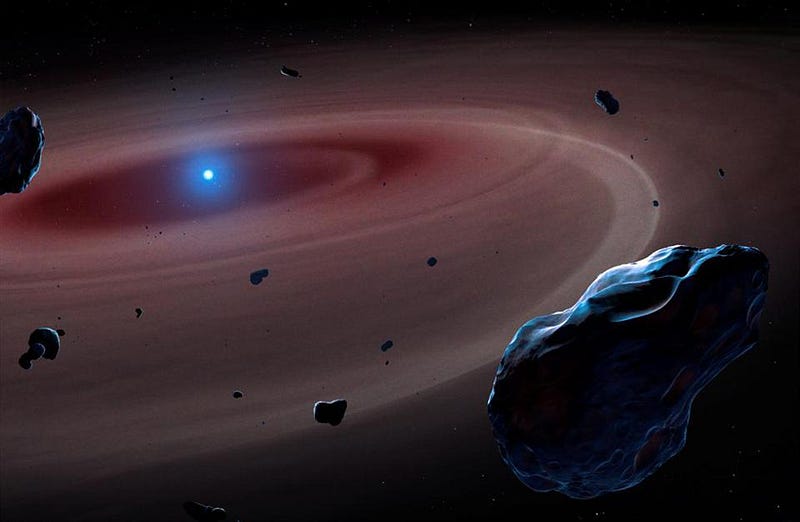
But there are two interesting caveats to all of this that we have to remember, above and beyond everything that’s already been brought up. First off, this white dwarf is extremely low in mass: about 52% the mass of the Sun. Stars that yield white dwarfs this low in mass, naturally, live longer than the current age of the Universe. This suggests some sort of dynamical interaction was at play, ejecting a portion of the progenitor star’s mass. And second off, we don’t have any information about what this star systems configuration was billions of years ago.
Could there have been a binary companion that siphoned off a large portion of the star’s mass during the giant phase, and was subsequently ejected? Or, perhaps, was the white dwarf-exoplanet combination ejected from a previously larger system? In our modern Universe, we have only a snapshot of what things looks like when the light from these astronomical systems arrives. Their history is forever lost to us, and it will take a large set of observations to teach us exactly what exoplanetary systems truly exist around these stellar remnants.
We’re seeing the tip of the iceberg: a scientific field in its infancy. Over the coming years and decades, it will be the data we’ve yet to obtain that will teach us what types of planetary systems remain — and how abundant they are — when Sun-like stars meet their inevitable demise.
Send in your Ask Ethan questions to startswithabang at gmail dot com!
Starts With A Bang is written by Ethan Siegel, Ph.D., author of Beyond The Galaxy, and Treknology: The Science of Star Trek from Tricorders to Warp Drive.





